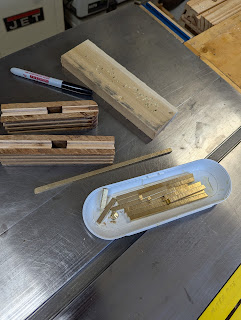In woodworking, mallets and hammers are basic tools, as basic as pick up trucks and bulldozers in road construction.
I've made as many wooden mallets as I could possibly and reasonably make. Hammers, I bought - new or at flea markets. Wooden mallets to have heft are typically humongous to be able to enforce the function that they were made for. Both steel hammers and wooden mallets are enforcers but lack subtlety for delicate and fine work, unless in their miniaturized versions. Japanese hammers with their narrow and skinny look come close to combining heft and accuracy. One slight flaw is that solid steel hammers vibrate at every strike.
My solution is a hybrid of wood and strips of brass rods embedded with epoxy in grooves I created along slender wooden heads. The finished projects allow for accuracy with just the proper heft with no vibration and better control. I dubbed them the sports cars next to the pick up trucks and bulldozers of full size hammers and bulky wooden mallets for fine and delicate work.
With my hand close to the mallet head gives me better control and accuracy for delicate work. By the way, even though I am typically right handed in most everything I do (writing and eating, for example), but I use tools left handed, including the use of kitchen knives. I customized these mallets to my left handed grip. For one mallet the grip is close to the head, which makes for an accurate and delicate strike.

























